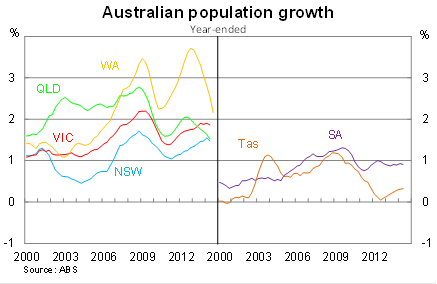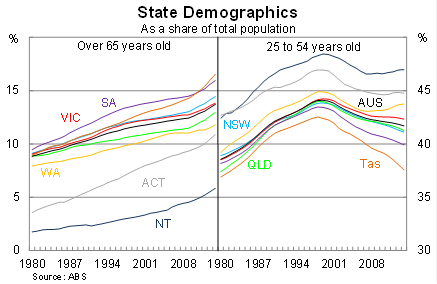Farewell to Australia's favourable demographics
The Australian economy continues to be underpinned by strong population growth, which remains elevated by international standards, but the pace of growth has eased considerably over the past year. A softer Australian dollar -- combined with the end of the mining boom -- should ease immigration rates over the next few years and weigh on population growth and by extension real GDP growth.
The Australian population rose by 1.6 per cent over the year to the June quarter -- reflecting strong growth on the east coast -- but the pace of growth has slowed considerably since the end of 2012 and further still from its pace at the onset of the global financial crisis.
New South Wales and Victoria continue to lead the way, with their population rising by 1.5 per cent and 1.9 per cent, respectively, over the past year. The population in New South Wales sits at 7.52 million and in Victoria at 5.84 million.
But the strongest growth remains in Western Australia, though that may not remain the case for much longer. With the mining boom now over -- and what were once mining towns now turning into ghost towns -- population growth should continue to ease in the west over the next few years.


By comparison, population growth remains weak in South Australia and Tasmania, reflecting a long period of economic malaise.
Economic opportunity is one of the leading factors behind population growth. That helps explain the relative strength in Western Australia and Queensland in recent years. The number of opportunities -- particularly for low-skilled workers -- has understandably made these states a hot spot for new immigrants as well as those living interstate.
States such as New South Wales and Victoria also benefit from the appeal of big city living. They offer an inner city experience that cannot yet be replicated anywhere else in Australia.
Getting the right balance on population growth is difficult. I've been critical of our federal government's blind preference for a ‘Big Australia' because it has been pursued with little regard for our existing infrastructure or our natural resources. But low population growth can also be problematic by creating limited market size and economies of scale.
Attracting capital investment to states with soft population growth can be difficult, particularly for the likes of South Australia and Tasmania where the population is small to begin with.
Another trend worth keeping an eye on is Australia's ageing population. This has been well documented at the national level but each state will be affected differently.
Favourable demographics -- as seen below -- have supported the Australian economy over the past few decades. The share of the population aged between 25 and 54 years of age -- considered prime working years -- increased sharply between 1980 until its peak earlier this century.


This helped create a sweet spot for economic growth and -- combined with rising labour force participation among women -- created the perfect environment for strong economic growth. But that period is clearly at an end, with the share of the population between 25 and 54 years old now on the decline.
That effect has been felt most in low population states such as Tasmania and South Australia. Tasmania in particular is noticeably older than other states, with a low share of their population within the 25 to 54 years old age group.
These are trends that will continue for the foreseeable future. Population growth should continue to ease as a lower dollar makes Australia a less attractive destination for immigration.
Meanwhile an ageing population will continue to subtly weigh on growth. It won't always be noticeable but over time it will result in a period of growth that is uncommonly low for a country that has experienced such a long period of economic prosperity.













